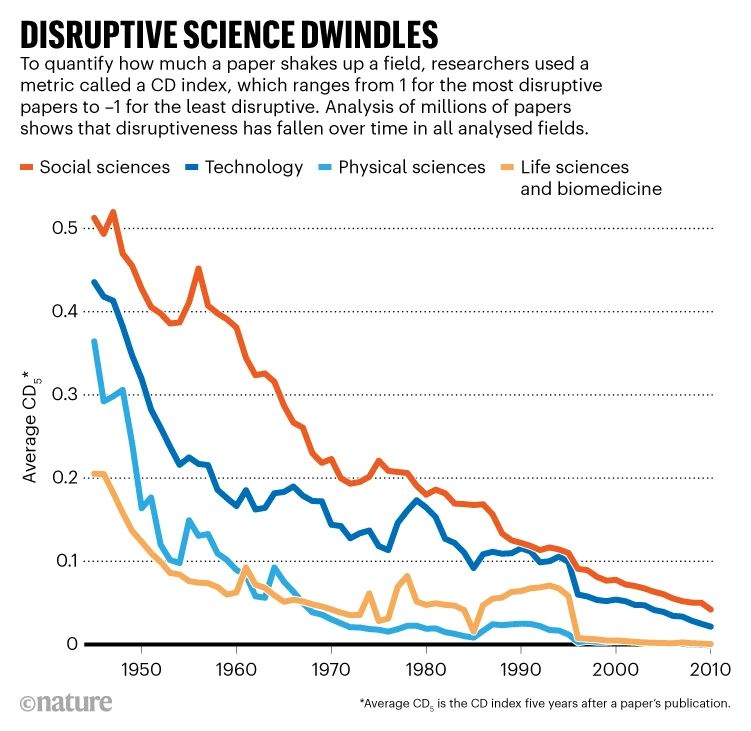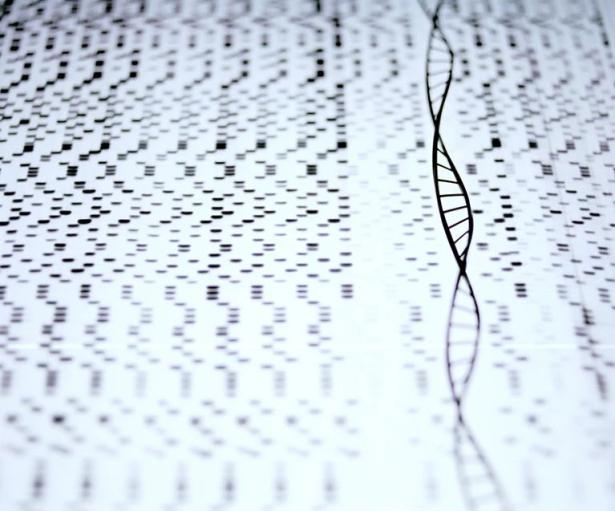The number of science and technology research papers published has skyrocketed over the past few decades — but the ‘disruptiveness’ of those papers has dropped, according to an analysis of how radically papers depart from the previous literature1.
Data from millions of manuscripts show that, compared with the mid-twentieth century, research done in the 2000s was much more likely to incrementally push science forward than to veer off in a new direction and render previous work obsolete. Analysis of patents from 1976 to 2010 showed the same trend.
“The data suggest something is changing,” says Russell Funk, a sociologist at the University of Minnesota in Minneapolis and a co-author of the analysis, which was published on 4 January in Nature. “You don’t have quite the same intensity of breakthrough discoveries you once had.”
Telltale citations
The authors reasoned that if a study was highly disruptive, subsequent research would be less likely to cite the study’s references, and instead cite the study itself. Using the citation data from 45 million manuscripts and 3.9 million patents, the researchers calculated a measure of disruptiveness, called the ‘CD index’, in which values ranged from –1 for the least disruptive work to 1 for the most disruptive.
The average CD index declined by more than 90% between 1945 and 2010 for research manuscripts (see ‘Disruptive science dwindles’), and by more than 78% from 1980 to 2010 for patents. Disruptiveness declined in all of the analysed research fields and patent types, even when factoring in potential differences in factors such as citation practices.

Source: Ref. 1
The authors also analysed the most common verbs used in manuscripts and found that whereas research in the 1950s was more likely to use words evoking creation or discovery such as ‘produce’ or ‘determine’, that done in the 2010s was more likely to refer to incremental progress, using terms such as ‘improve’ or ‘enhance’.
“It’s great to see this documented in such a meticulous manner,” says Dashun Wang, a computational social scientist at Northwestern University in Evanston, Illinois, who studies disruptiveness in science. “They look at this in 100 different ways, and I find it very convincing overall.”
Other research2 has suggested that scientific innovation has slowed in recent decades, too, says Yian Yin, also a computational social scientist at Northwestern. But this study offers a “new start to a data-driven way to investigate how science changes”, he adds.
Disruptiveness is not inherently good, and incremental science is not necessarily bad, says Wang. The first direct observation of gravitational waves, for example, was both revolutionary and the product of incremental science, he says.
The ideal is a healthy mix of incremental and disruptive research, says John Walsh, a specialist in science and technology policy at the Georgia Institute of Technology in Atlanta. “In a world where we’re concerned with the validity of findings, it might be a good thing to have more replication and reproduction,” he says.
Why the slide?
It is important to understand the reasons for the drastic changes, Walsh says. The trend might stem in part from changes in the scientific enterprise. For example, there are now many more researchers than in the 1940s, which has created a more competitive environment and raised the stakes to publish research and seek patents. That, in turn, has changed the incentives for how researchers go about their work. Large research teams, for example, have become more common, and Wang and his colleagues have found3 that big teams are more likely to produce incremental than disruptive science.
Finding an explanation for the decline won’t be easy, Walsh says. Although the proportion of disruptive research dropped significantly between 1945 and 2010, the number of highly disruptive studies has remained about the same. The rate of decline is also puzzling: CD indices fell steeply from 1945 to 1970, then more gradually from the late 1990s to 2010. “Whatever explanation you have for disruptiveness dropping off, you need to also make sense of it levelling off” in the 2000s, he says.
doi: https://doi.org/10.1038/d41586-022-04577-5
References
-
Park, M., Leahey, E. & Funk, R. J. Nature 613, 138–144 (2023).
-
Cowen, T. & Southwood, B. Preprint at SSRN http://doi.org/10.2139/ssrn.3822691 (2019).
-
Wu, L., Wang, D. & Evans, J. A. Nature 566, 378–382 (2019).
As a kid, Max Kozlov was dead set on one day becoming the next famous meteorologist or pharmacist.
He was fascinated by trips to the Museum of Science in Boston, where he could pretend to be a scientist even though he couldn't speak English well, as his entire family moved to the Boston area from Ukraine a few years before he was born. Admittedly, Max is obsessed with his babushka’s borscht.
All through high school and into college, Max worked at the Museum of Science teaching science in the very same exhibit he once visited as a child. His favorite part of the job: putting on a giant bee costume and pretending to buzz around like a bee with young visitors to teach them how bees make honey.
He studied cognitive neuroscience at Brown University as a first-gen student. After graduating, Max was awarded the 2020 AAAS Mass Media Fellowship, where he covered science at the St. Louis Post-Dispatch.
Today, he writes for Nature as a life-sciences reporter.
His work has also appeared in The Atlantic, Quanta Magazine, The Scientist, The St. Louis Post-Dispatch, Behavioral Scientist, and The Public’s Radio.
In his free time, he loves to rock climb, participate in research studies, and devour just about every journalistic piece he comes across.
To this day, he's still fascinated by the weather and medicine and, who knows, hopefully he’s making childhood Max proud by writing about science.
Follow Max on Twitter to stay up-to-date on his latest stories.
Nature is a weekly international journal publishing the finest peer-reviewed research in all fields of science and technology on the basis of its originality, importance, interdisciplinary interest, timeliness, accessibility, elegance and surprising conclusions. Nature also provides rapid, authoritative, insightful and arresting news and interpretation of topical and coming trends affecting science, scientists and the wider public.
First, to serve scientists through prompt publication of significant advances in any branch of science, and to provide a forum for the reporting and discussion of news and issues concerning science. Second, to ensure that the results of science are rapidly disseminated to the public throughout the world, in a fashion that conveys their significance for knowledge, culture and daily life.
Nature's original mission statement was published for the first time on 11 November 1869.


Spread the word